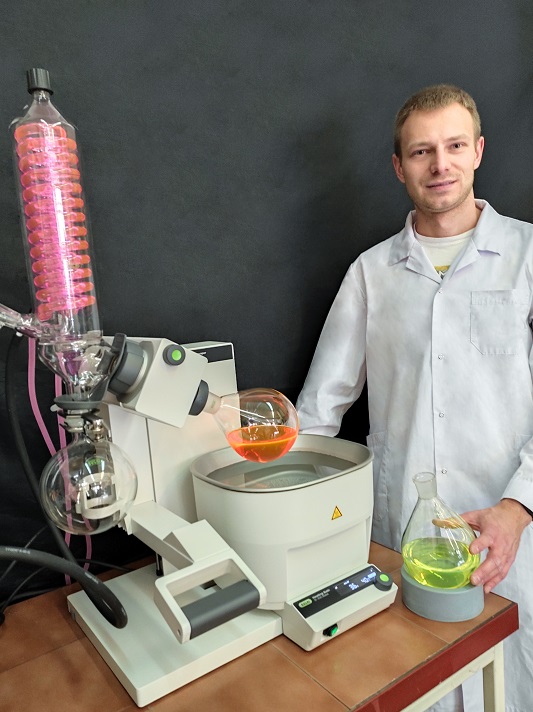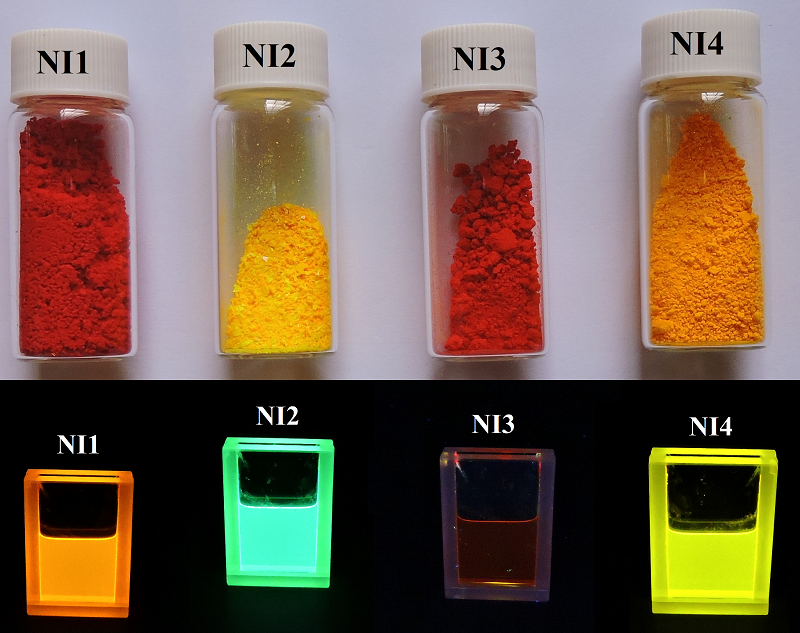RESEARCH EXCELLENCE INITIATIVE
FREEDOM OF RESEARCH – SCIENCE FOR THE FUTURE
“Freedom of research – science for the future” series consists of articles, interviews and short videos presenting research conducted by the winners of “Freedom of research” call for proposals
Marek Matussek, PhD | chemist
OLED technology and the future of organic electronics
|Weronika Cygan|
Realistic colour reproduction, impeccable blacks combined with high contrast, and the highest possible image resolution at the same time – these are the contemporary requirements for TV and smartphone displays. Chemists and synthesists deal with the design of functional molecular and polymeric materials on which modern optoelectronic circuits are based. A team of scientists from the Faculty of Science and Technology of the University of Silesia in Katowice, co-created by Marek Matusek, PhD, is working on a certain group of organic compounds that could potentially find application in optoelectronic components of the devices mentioned above. The research is conducted under the “Freedom of Research” call for proposals, which is a part of the Research Excellence Initiative programme.

A University of Silesia smartwatch?
Scientists from the Faculty of Science and Technology at the University of Silesia synthesise new, efficient phosphors, in this case, low-molecular-weight organic compounds exhibiting electroluminescence (light emission under the influence of externally applied electric potential difference). Carbon-based materials must exhibit suitable physicochemical properties to be used in broadly understood optoelectronic technology (smartphones, TVs, smartwatches).
Currently, four new molecular materials based on the structure of naphthalene imide, synthesised by Marek Matusek, PhD, are tested in the laboratory at the University of Silesia. So far, the results are in line with predictions, but it may take another six months of tests before the full commercial potential of these materials can be determined.
“It’s a bit like building a castle out of Lego bricks. From individual small elements we create something with a much more complex structure,” explains the scientist. He stresses that the transition from the OLED diode itself to the device is a complex process and requires a number of additional steps, such as selecting the appropriate matrix which controls the individual pixels through which the image is generated.
Possibilities of OLEDs
But what are OLEDs[1] and what makes them a gauntlet thrown down to traditional LEDs[2]? Marek Matussek believes that OLEDs compare to LEDs like a Ferrari to a Fiat 126p. “There is a staggering difference,” he emphasises. In his opinion the prospects are promising. “I am convinced that OLED technology will replace LEDs based on inorganic semiconductors, we just don’t know how fast it will happen.”
The most important asset is the incomparable quality of the image. It’s just aesthetics – a very important argument from the consumer’s point of view. The screens based on OLED technology are capable of displaying excellent blackness, thanks to which it is possible to obtain almost unlimited contrast. In addition, colour reproduction is much more realistic. Other noteworthy advantages of screens “armed” with OLED technology are the almost nonexistent degradation of colour when viewed from a wide angle, a much faster response time allowing to reduce the effect of eye fatigue and to maintain the sharpness of dynamic images at high brightness of the screen.

An increasingly common technology
Although to some people the word OLED still sounds rather exotic, Marek Matussek assures us that this technology is already widely used in mobile phones from the upper price range. Smartwatches and smartbands also have them. He adds, however, that it is still easier to implement this technology for small displays, hence the competition between displays based on inorganic semiconductors (LEDs) and those based on organic LEDs (OLEDs) is still taking place when it comes to TVs.
However, progress is also evident in this field, as demonstrated by the price of large OLED TVs. They did not go for less than PLN 15,000 just a decade ago. Nowadays, they can be bought for PLN 4,000 to 5,000. Even though this is still a considerable expense, when compared with the price of LED products, this difference will only decrease in the future.
Commercial potential and cooperation
The work of the team from the Faculty of Science and Technology at the University of Silesia focuses on the design, synthesis, and subsequent in-depth study of organic molecular materials with potential applications in organic electronics in the broad sense, especially in SM-OLED technology. Currently, research is being carried out on four luminescent materials obtained by Marek Matussek. “We have achieved the most important things, and the results are in line with predictions,” assures the scientist.
The interest of external companies in the conducted research is enormous. “Companies that use OLED technology follow the reports of scientific and research units and also cooperate with such units,” he adds.
However, close ties connect not only research centres with manufacturers of electronics but also individual universities. The team from the Faculty of Science and Technology of the University of Silesia cooperates closely with specialists from the Silesian University of Technology and the Warsaw University of Technology. This results in a valuable exchange of experience and knowledge. Marek Matussek concludes that in science ruthless competition would bring poor results. It is more profitable to cooperate and carry out work in many directions at the same time.
[1] OLED – Organic Light-Emitting Diode, in which the light emitter in the active layer is a small-molecule (SM-OLED) or polymer (P-OLED) organic compound.
[2] LED – a traditional Light-Emitting Diode, whose structure is based on inorganic semiconductor materials (mostly silicon or germanium).





